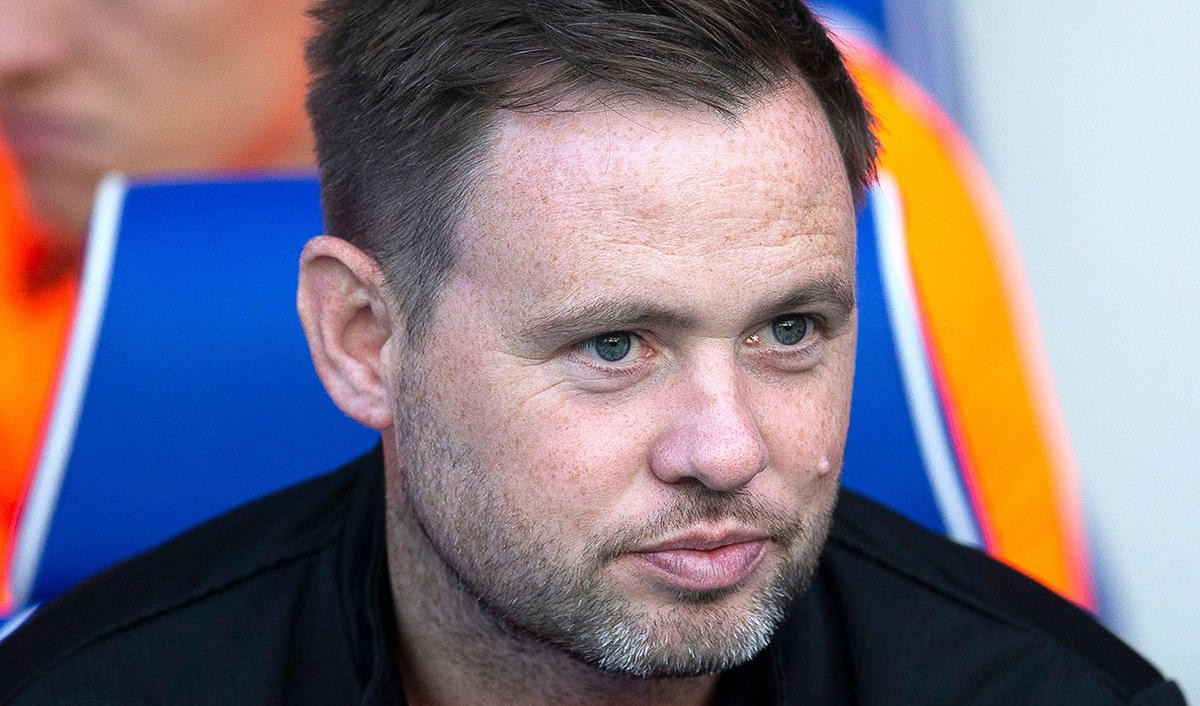




OUR BEST EVER OFFER - SAVE £100/$100
JOIN THE WORLD'S LEADING PROFESSIONAL DEVELOPMENT PROGRAMME
- 12 months membership of Elite Soccer
- Print copy of Elite Player & Coach Development
- Print copy of The Training Ground
You are viewing 1 of your 1 free articles
Improving the central diamond
This session is designed to improve team movement and rotations when in possession of the ball. The session shows the example of working with a central diamond consisting of three midfielders and a number 9.
| Area | Full pitch |
| Equipment | Balls, bibs, 2 full size goals |
| No. of Players | 20 players + 2 goalkeepers |
| Session Time |
Entire session: 40mins |
This session is designed to improve team movement and rotations when in possession of the ball. The session shows the example of working with a central diamond consisting of three midfielders and a number 9. A very fluid approach, the movement of this diamond rotates the team’s attack into different formations, from 4-3-3 to 3-4-1-2 to a 4-4-2 diamond to 4-3-2-1.
I first began to use this organisation as a youth coach at Liverpool and I have continued to use variations of it in my time coaching at Sao Paulo and Rangers.
By developing this kind of fluid attacking organisation, it can make teams very unpredictable to play against. Naturally, team selections will change during the course of a season due to injuries, form, suspension and through tactical decisions, and this organisation gives teams plenty of flexibility and allows players to bring their own unique qualities to the team when selected. It also allows teams to attack specific areas that have been highlighted as opposition weaknesses.
This type of practice is one that coaches would run regularly both in team sessions, unit sessions and off-pitch video analysis.
EXPLAINING THE THEORY
We set up on a full size pitch with a goal and a goalkeeper at one end. We’re using 10 outfield players, with the four yellow players functioning as the team’s midfield diamond and the six blues serving as the remainder of the team.
We would set the players up, as shown [1a], using a number 6 at the base of the diamond, a number 9 at the tip of the diamond, and two number 8s, one on each side of the diamond. Then we would walk the players through the basic ideas and theory, pointing out the central diamond and explaining how it can move up and down the pitch to create different possibilities in each area.
1a
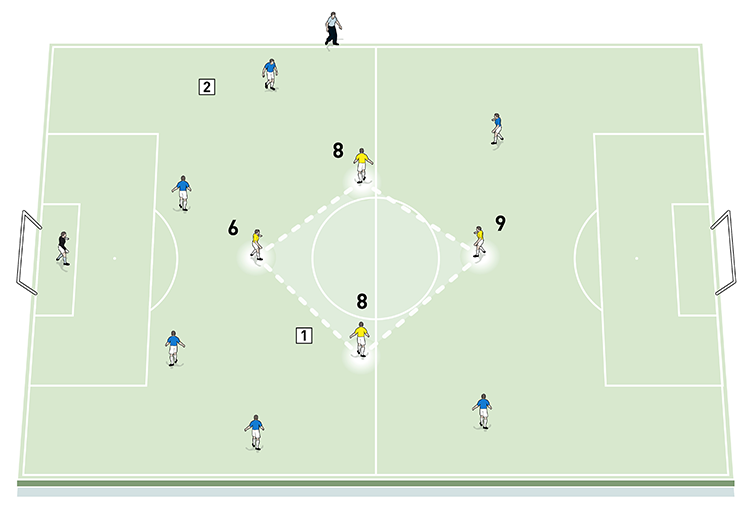
2. The coach talks the players through the theory, highlighting the central diamond and explaining how it can move up and down the pitch to create different possibilities
For example, if the number 6 drops deep between the centre backs to receive the ball, the whole central diamond drops. The players outside the diamond open up or go higher, as shown [1b]. Whereas, if the number 6 moves up the pitch, the whole diamond moves higher and the players outside the diamond adjust accordingly, as shown [1c].
1b
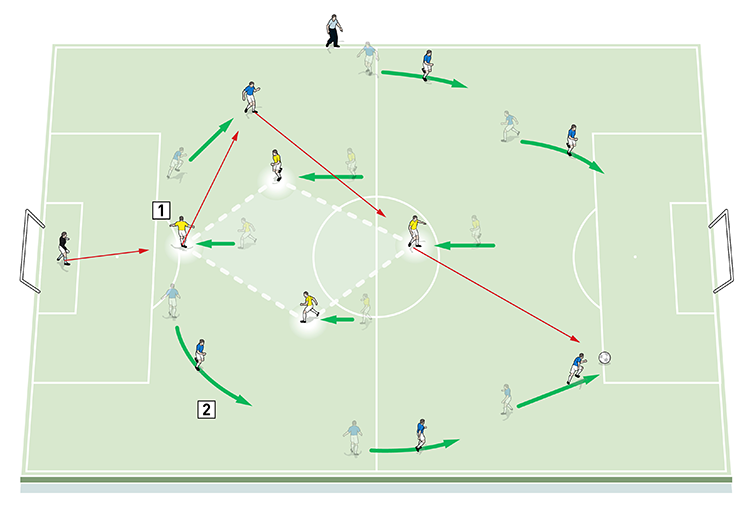
2. The players outside the diamond open up or go higher
1c
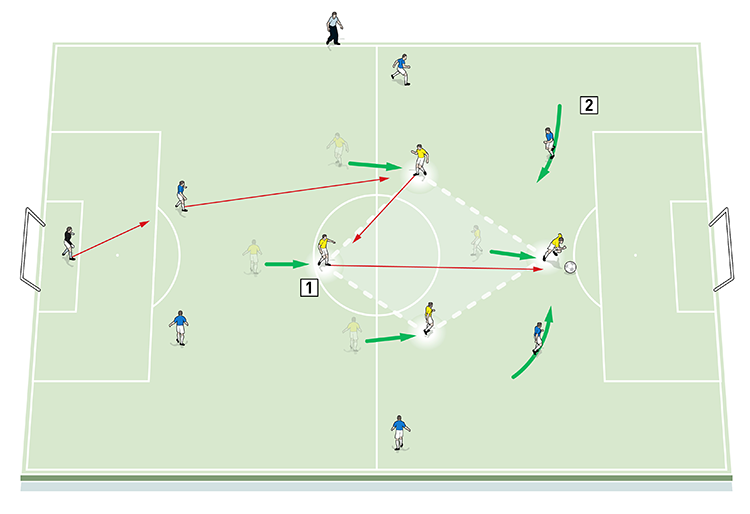
2. The players outside the diamond adjust accordingly
MOVING THE DIAMOND
We now practice the movements using two full teams of 11 players, each with a midfield diamond moving as explained in the theory part of the session. The two teams alternate building up to attack unopposed.
Attack 1: Coach 1 passes to the blue team’s left back and the blues build up unopposed to score, as shown [2a]. The red team rests while this attack is taking place. After the blue attack is dead, coach 1 launches a second attack by passing to the red team’s right back who begins an unopposed attack [not shown], while the blue team rests. Each team runs four of these attacks, with the teams alternating.
2a

2. The midfield diamond reacts according to the situation, here moving up the pitch
3. The red team rests while this attack is taking place. Once the blue attack is dead, the reds run the same attack with a starting pass from coach 1 to the red team’s right back
Attack 2: Coach 2 starts an unopposed attack for the blues starting with a pass to the right back [not shown]. The reds remain passive. When the attack is dead, coach 2 starts a second attack by passing to the red team’s left back, who begins an unopposed attacking move [not shown] while the blues remain passive. Each team runs four of these attacks, with the teams alternating.
Attack 3: Coach 3, who is positioned to the side of the blue goal, plays a starting pass to the blue goalkeeper, who builds an unopposed attack from the back while the reds rest, as shown [2b]. After this attack is dead, coach 4, who is positioned to the side of the red goal, plays a starting pass to the red goalkeeper who launches an unopposed attack by building up play from the back [not shown]. Each team runs four of these attacks, with the teams alternating and each team’s midfield diamond reacting according to the situation.
2b
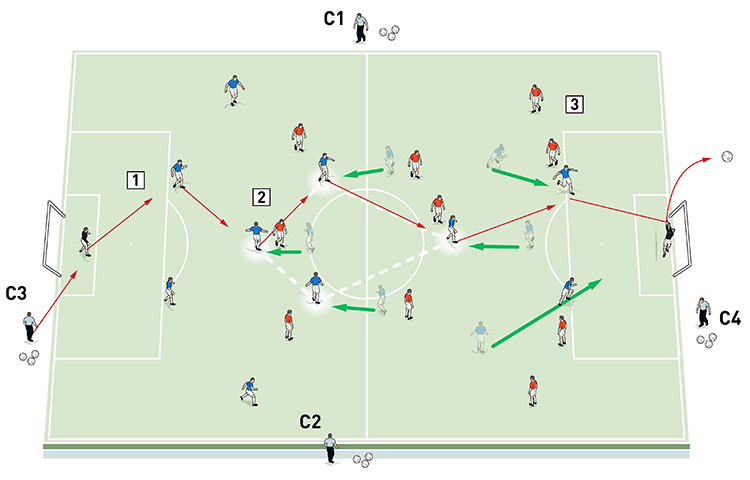
2. The midfield diamond reacts according to the situation, here dropping to receive
3. The red team are inactive during this attack. Once the blue attack is dead, the reds run the same attack with a starting pass from coach 4 to the red team’s keeper, who builds play from the back
To help put the theory into practice, a coach is nominated for each team, to speak specifically to their own team and encourage different movements. In total, each team makes 12 unopposed attacks, with their coaches encouraging the players to build up in different ways by moving the central diamond higher or lower on the pitch to force rotations between the team’s shape.
COACHING POINTS
What are the key things to look for?
The central diamond is linked by some clear rules. Make sure players understand that if the number 6 is down, the number 8s are down and the number 9 is now free. But if the number 6 is high, the number 8s are wider and the number 9 is high.
Width is provided by the full backs who work closely with the wide attackers. If the full backs are higher, the wide attackers can come inside and into advanced positions.
What are the typical mistakes players might make and how do I avoid them?
In all scenarios, firstly the team needs to have width in order to give it the option of going around the opposition block to dribble or cross. And secondly, the team must create movement in the last line of the opposition (the defence). This is key to creating space for the players on the ball, whilst also disrupting the defence in order to receive passes into the space behind or down the sides of the centre backs.
How would I put this in a game situation?
Finish the session by playing a normal game [not shown]. We would play two games of 10 minutes. In the first game, whenever the ball leaves play, the game will restart with the blue team. In the second game this rule will be applied to the red team.
The coaches can restart the game from various areas on the pitch to create different situations and replicate the complexity of the real game. The coaches should pay close attention to the relationships in the central diamond as the team build to attack.
Related Files
Editor's Picks
Attacking transitions
Deep runs in the final third
Using the goalkeeper in build-up play
Intensive boxes drill with goals
Penetrating the final third
Creating and finishing
My philosophy
Pressing initiation
Compact team movement
Coaches' Testimonials

Alan Pardew

Arsène Wenger

Brendan Rodgers

Carlos Carvalhal

José Mourinho

Jürgen Klopp

Pep Guardiola

Roy Hodgson

Sir Alex Ferguson

Steven Gerrard
Coaches' Testimonials

Gerald Kearney, Downtown Las Vegas Soccer Club

Paul Butler, Florida, USA

Rick Shields, Springboro, USA

Tony Green, Pierrefonds Titans, Quebec, Canada
Join the world's leading coaches and managers and discover for yourself one of the best kept secrets in coaching. No other training tool on the planet is written or read by the calibre of names you’ll find in Elite Soccer.
In a recent survey 92% of subscribers said Elite Soccer makes them more confident, 89% said it makes them a more effective coach and 91% said it makes them more inspired.
Get Monthly Inspiration
All the latest techniques and approaches
Since 2010 Elite Soccer has given subscribers exclusive insight into the training ground practices of the world’s best coaches. Published in partnership with the League Managers Association we have unparalleled access to the leading lights in the English leagues, as well as a host of international managers.
Elite Soccer exclusively features sessions written by the coaches themselves. There are no observed sessions and no sessions “in the style of”, just first-hand advice delivered direct to you from the coach.
